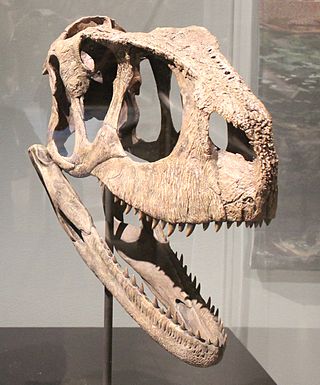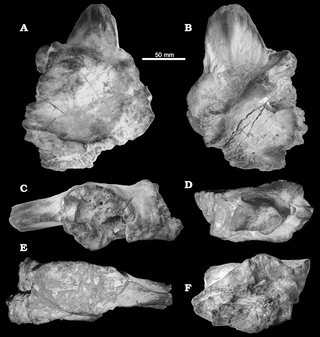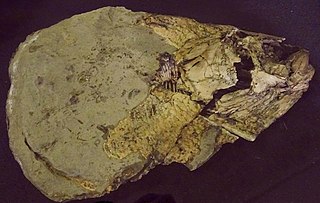
Spinosaurus is a genus of spinosaurid dinosaur that lived in what now is North Africa during the Cenomanian stage of the Late Cretaceous period, about 100 to 94 million years ago. The genus was known first from Egyptian remains discovered in 1912 and described by German palaeontologist Ernst Stromer in 1915. The original remains were destroyed in World War II, but additional material came to light in the early 21st century. It is unclear whether one or two species are represented in the fossils reported in the scientific literature. The type species S. aegyptiacus is mainly known from Egypt and Morocco. Although a potential second dubious species, S. maroccanus, has been recovered from Morocco, this dubious species is likely a junior synonym of S. aegyptiacus. Other possible junior synonyms include Sigilmassasaurus from the Kem Kem beds in Morocco and Oxalaia from the Alcântara Formation in Brazil, though other researchers propose both genera to be distinct taxa.

Carcharodontosaurus is a genus of carnivorous theropod dinosaur that lived in Northwest Africa from about 100 to 94 million years ago during the Cenomanian age of the Cretaceous. Two teeth of the genus, now lost, were first described from Algeria by French paleontologists Charles Depéret and Justin Savornin as Megalosaurus saharicus. A partial skeleton initially referred to this genus was collected by crews of German paleontologist Ernst Stromer during a 1914 expedition to Egypt. Stromer did not report the Egyptian find until 1931, in which he dubbed the novel genus Carcharodontosaurus, making the type species C. saharicus. This skeleton was destroyed during the Second World War, and has subsequently been redescribed as the holotype of a distinct carcharodontosaurid genus, Tameryraptor. In 1995, a nearly complete skull of C. saharicus, the first well-preserved specimen to be found in almost a century, was discovered in the Kem Kem Beds of Morocco, which was officially designated as the neotype in 2007. In the same year, fossils unearthed from the Echkar Formation of northern Niger were described and named as another species, C. iguidensis, though this species might belong to a different genus.

Rugops is a monospecific genus of basal abelisaurid theropod dinosaur from Niger that lived during the Late Cretaceous period in what is now the Echkar Formation. The type and only species, Rugops primus, is known only from a partial skull. It was named and described in 2004 by Paul Sereno, Jeffery Wilson and Jack Conrad. Rugops has an estimated length of 4.4–5.3 metres (14–17 ft) and weight of 410 kilograms (900 lb). The top of its skull bears several pits which correlates with overlaying scale and the front of the snout would have had an armour-like dermis.

Bahariasaurus is a dubious, enigmatic genus of large theropod dinosaur. The genus is known to have included at least 1 species, Bahariasaurus ingens, which was found in North African rock layers dating to the Cenomanian age of the Late Cretaceous. The only fossils confidently assigned to Bahariasaurus were found in the Bahariya Formation of the Bahariya oasis in Egypt by Ernst Stromer but were destroyed during a World War II bombing raid with the same raid taking out the holotype of Spinosaurus and Aegyptosaurus among other animals found in the Bahariya Formation. While there have been more fossils assigned to the genus such as some from the Farak Formation of Niger, these remains are referred to with much less certainty. Bahariasaurus is, by most estimations, one of the largest theropods, approaching the height and length of other large bodied theropods such as Tyrannosaurus rex and the contemporaneous Carcharodontosaurus. The aforementioned estimations tend to put it at around 11–12.2 metres in length and 4-4.8 tonnes in overall weight.

Deltadromeus is a genus of theropod dinosaur from the Aoufous Formation of Morocco.

Sigilmassasaurus is a controversial and dubious genus of spinosaurid dinosaur that lived approximately 100 to 94 million years ago during the Late Cretaceous Period in what is now northern Africa. Named in 1996 by Canadian paleontologist Dale Russell, it contains a single species, Sigilmassasaurus brevicollis. The identity of the genus has been debated by scientists, with some considering its fossils to represent material from the closely related species Spinosaurus aegyptiacus, while others have classified it as a separate taxon, forming the clade Spinosaurini with Spinosaurus as its sister taxon.

Axelrodichthys is an extinct genus of mawsoniid coelacanth from the Cretaceous of Africa, North and South America, and Europe. Several species are known, the remains of which were discovered in the Lower Cretaceous (Aptian-Albian) of Brazil, North Africa, and possibly Mexico, as well as in the Upper Cretaceous of Morocco (Cenomanian), Madagascar and France. The Axelrodichthys of the Lower Cretaceous frequented both brackish and coastal marine waters while the most recent species lived exclusively in fresh waters. The French specimens are the last known fresh water coelacanths. Most of the species of this genus reached 1 metre to 2 metres in length. Axelrodichthys was named in 1986 by John G. Maisey in honor of the American ichthyologist Herbert R. Axelrod.

Mawsonia is an extinct genus of prehistoric coelacanth fish. It is amongst the largest of all coelacanths, with one quadrate specimen possibly belonging to an individual measuring 5.3 metres in length. It lived in freshwater and brackish environments from the late Jurassic to the mid-Cretaceous of South America, eastern North America, and Africa. Mawsonia was first described by British paleontologist Arthur Smith Woodward in 1907.

The Kem Kem Group is a geological group in the Kem Kem region of eastern Morocco, whose strata date back to the Cenomanian stage of the Late Cretaceous. Its strata are subdivided into two geological formations, with the lower Ifezouane Formation and the upper Aoufous Formation used for the strata on the eastern side of the Atlas Mountains (Tinghir), with the Gara Sbaa Formation and Douira Formation used in the southern Tafilalt region. It is exposed on an escarpment along the Algeria–Morocco border.

Paranogmius is an extinct genus of prehistoric bony fish that lived during the Cenomanian. It is known from only 2 partial skulls and several dorsal vertebrae discovered in the Bahariya Formation that was destroyed during World War II. Since then, no more fossils have been discovered. It may have been up to 3 meters long.

Stomatosuchidae is an extinct family of neosuchian crocodylomorphs. It is defined as the most inclusive clade containing Stomatosuchus inermis but not Notosuchus terrestris, Simosuchus clarki, Araripesuchus gomesii, Baurusuchus pachecoi, Peirosaurus torminni, or Crocodylus niloticus. Two genera are known to belong to Stomatosuchidae: Stomatosuchus, the type genus, and Laganosuchus. Fossils have been found from Egypt, Morocco, and Niger. Both lived during the Cenomanian stage of the Late Cretaceous. The skulls of stomatosuchids are said to be platyrostral because they have unusually flattened, elongate, duck-shaped craniums with U-shaped jaws. This platyrostral condition is similar to what is seen in the "nettosuchid" Mourasuchus, which is not closely related to stomatosuchids as it is a more derived alligatoroid that existed during the Miocene.

Onchopristis is an extinct genus of sclerorhynchoid from the Cretaceous of North Africa, Europe, North America, and potentially South America. It contains two valid species, O. numida and O. dunklei, though some researchers argue that both may be considered a single taxon with variation in morphology caused by a wide geographical range. Specimens of Onchopristis have been discovered in coastal and fluvial deposits dated from the Barremian to the Cenomanian ages, making this genus one of the oldest known sclerorhynchoid.

Sauroniops is a controversial, potentially dubious, genus of carnivorous basal carcharodontosaurid theropod dinosaur known from the Late Cretaceous of Morocco. It is mainly known from the Gara Sbaa Formation of the Kem Kem beds and contains a single species, S. platytholus.
The Aoufous Formation is a geological formation that contains some of the vertebrate assemblage of the Kem Kem Group, of Late Cretaceous date. It underlies the Ifezouane Formation and overlies the Akrabou Formation.

Bachea is an extinct genus of ray-finned fish that lived during the Late Cretaceous in what is now central Colombia, South America. The type species is Bachea huilensis, described in 1997 by María Páramo from the Turonian of Huila, Colombia.

Leptostomia is a genus of long-beaked pterosaur from the mid-Cretaceous (Cenomanian) of Morocco, North Africa. The type species is L. begaaensis, which was named and described in 2021 from sediments of the Kem Kem Group in Morocco. It was a small animal with a long, slender bill which is thought to have been used to probe sediments for worms and other invertebrates, similar to kiwi birds and curlews. Leptostomia is likely a member of the Azhdarchoidea.
Oniichthys is an extinct genus of gar in the family Lepisosteidae. It contains a single species, O. falipoui, known from the Late Cretaceous (Cenomanian) of Morocco.
Afrocascudo is a controversial genus of extinct neopterygian fish, either an ancient loricariid catfish or a juvenile obaichthyid lepisosteiform of the genus Obaichthys. It is known from the Late Cretaceous Douira Formation of Morocco. The genus contains a single species, A. saharaensis, known from a partial articulated specimen.

The Akrabou Formation is a Late Cretaceous -aged geological formation and Konservat-Lagerstätte in Morocco. It overlies the slightly older freshwater deposits of the Kem Kem Group, which it was once thought to be apart of. It was deposited over following the Kem Kem ecosystem's submergence by the Tethys Ocean during a marine transgression from the Cenomanian-Turonian boundary event, as part of a wider deposition of carbonate platforms across the region from the event.

Tameryraptor is an extinct genus of large carcharodontosaurid theropod dinosaurs from the Late Cretaceous Bahariya Formation of Egypt. The genus contains a single species, T. markgrafi, known from partial skull bones and vertebrae, and leg bones. The holotype specimen was historically assigned to the genus Carcharodontosaurus, and it was destroyed in a bombing during the Second World War in 1944. Tameryraptor is one of the only African carcharodontosaurids to preserve associated cranial and postcranial remains.























